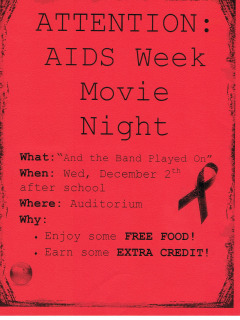Health educator Robert Sorenson came to inform students about HIV and AIDS
Three days in a hospital waiting for death after 10 years of perfect health. The crash and die scenario begins.
 On Dec. 2, 2009, Kaiser Permanente health educator Robert Sorenson came to MVHS for AIDS Week. Because he deals with HIV patients on a daily basis, Community Leadership’s Global Commission knew that hearing from Sorenson would be a valuable experience for the 200 students that attended.
On Dec. 2, 2009, Kaiser Permanente health educator Robert Sorenson came to MVHS for AIDS Week. Because he deals with HIV patients on a daily basis, Community Leadership’s Global Commission knew that hearing from Sorenson would be a valuable experience for the 200 students that attended.
In one day, Sorenson sees up to 21 patients in 15-minute intervals, where he gives STD tests and talks to the patients about the new lives they will have to create for themselves.
"[AIDS patients] will live married to their doctor," Sorenson said.
Not only did he give information about his job, but he also gave a background on the initial days of AIDS and precautions to prevent contracting any STD’s. Back in 1995, the first medicine was created for AIDS. During that time, nobody had a clear understanding of the disease. People were afraid, confused and paranoid.
"People were dressing in plastic," Sorenson said.
Sorenson stressed the use of condoms, and says that if they were used all the time, HIV would largely go away.
And so would the crash and die scenario. A careless one time fling with no precautions can lead to a disease that goes under the radar for a long time, leading to a surprise attack and days in the hospital. And that can easily erase anyone.
{cc-by-nc-sa}








